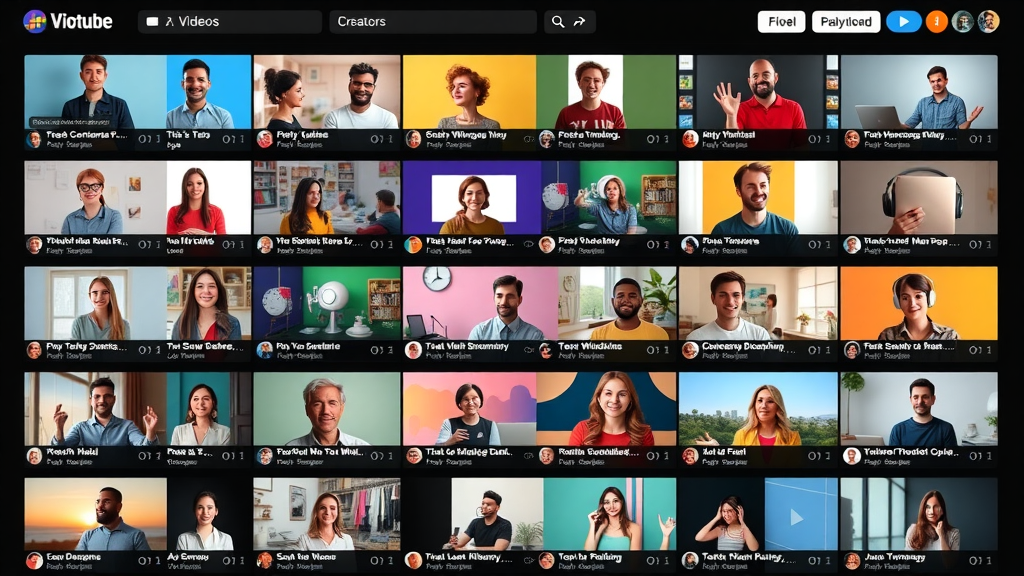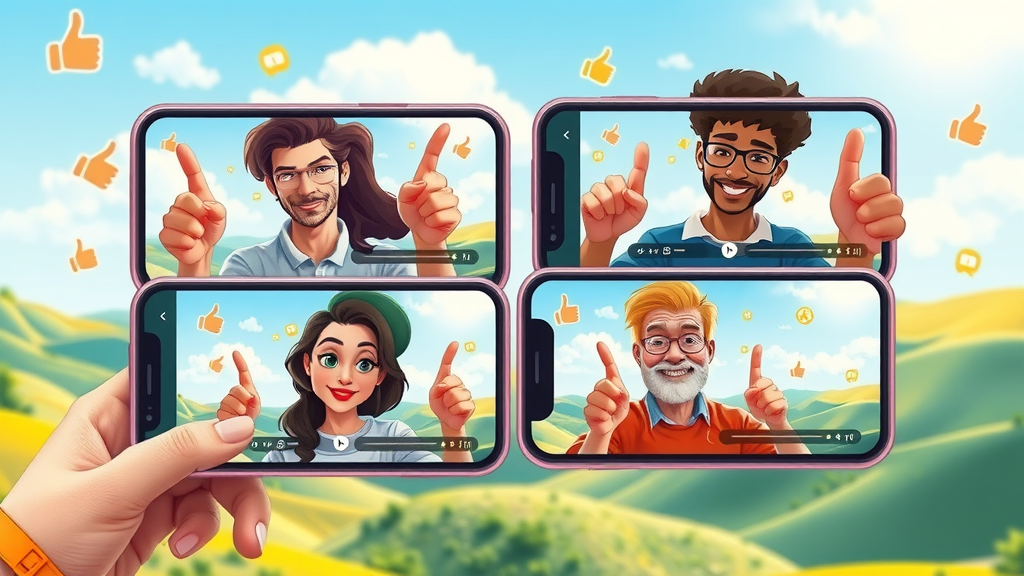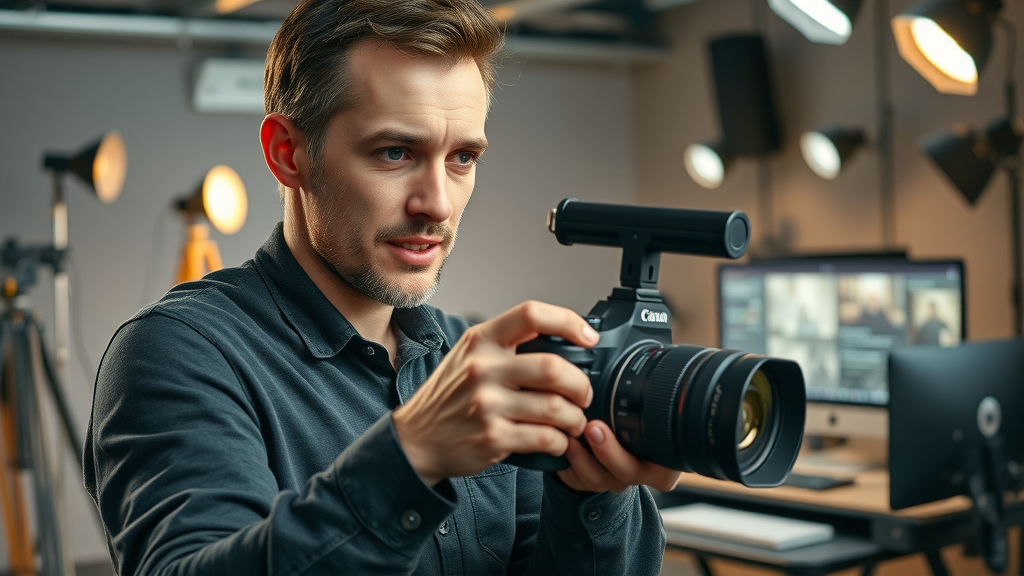Did you know viewers retain 95% of a message when watching it in a video, compared to just 10% when reading text? As attention spans drop and audiences crave dynamic media, engagement with video content has become the game-changer for anyone seeking to dominate on social media. Want to transform your strategy and leave your competitors behind? Dive in to uncover why video marketing is the most powerful tool for building loyal audiences and driving conversions.
- Actionable strategies to maximize engagement with video content
- Nuances of video engagement and key statistics
- Understanding various types of video
- Ways video marketing unlocks social sharing and higher engagement rate
Engagement with video content has skyrocketed over the last decade, becoming the backbone of successful social media strategies across industries. According to recent reports, video engagement is outpacing all other content types on every major media platform. For instance, on Facebook, videos see at least 59% more engagement than other post formats, and brands that use video marketing experience up to 49% faster revenue growth compared to those that don’t. This impressive trend isn’t just about reach; it’s about creating authentic connections and memorable experiences that boost audience interaction, drive social sharing, and lead to higher engagement rates .
Consider the sheer scale of online video consumption: In the United States alone, digital video viewing accounts for nearly three hours per day per person, as individuals gravitate toward highly engaging, entertaining, or informative clips. Whether it’s explainer videos, live streams, or product demos , effective video content resonates with viewers by delivering information visually—and emotionally. The power of video lies not only in its ability to communicate but also in its potential to inspire, educate, and catalyze audience actions across different media platforms.

Why Engagement with Video Content Is Dominating Social Media
Video content dominates social media for a simple reason: it delivers instant value and emotional impact . As online audiences scroll through their feeds, compelling video content stops the thumb, drawing viewers into a story, a product, or a cause in seconds. Unlike static images or plain text, videos combine visuals, audio, and motion to create an immersive experience that speaks directly to an audience's attention span. Marketers and brands recognize this, making video marketing a cornerstone strategy for higher engagement.
Another key factor fueling video dominance is the built-in social sharing culture on platforms like TikTok, Instagram, and YouTube. These channels encourage likes, comments, and shares, organically expanding reach and increasing engagement rate. Audiences are more likely to share videos with friends and followers, helping brands achieve viral growth while simultaneously enhancing lead gen and brand recognition. This ripple effect is unique to video content, making it the powerhouse for digital transformation on any social media platform.
Stop the Scroll: How Video Content Captures and Sustains Audience Attention
In today's digital world, where the average attention span has dropped to just eight seconds, capturing—and keeping—viewers engaged with video content is more challenging than ever. The secret lies in creating video content that not only grabs attention instantly but also sustains it through storytelling, interactive elements, and dynamic editing. When executed correctly, even a five-second introduction can boost viewer retention and set the stage for higher engagement rates.
For brands, this means focusing on strong visual hooks in the opening moments. On platforms like Instagram Reels and TikTok, fast-paced edits, bold graphics, and relatable scenarios keep viewers glued to the screen. Social sharing surges when videos evoke emotion—whether it's excitement, curiosity, or laughter—while effective video storytelling builds trust and loyalty. Engagement with video content hinges on how well you cater to rapidly shifting viewer expectations and the unique behaviors of each social media platform.

Grabbing and Holding Short Attention Spans with Video Engagement
To maximize video engagement , your content must be engineered for brevity and impact. Short, punchy video formats like TikTok clips or Instagram Stories thrive because they align with the audience's craving for instant, digestible entertainment. The first three seconds are crucial: using vibrant visuals, celebrity endorsements, surprising facts, or teasing a payoff later in the video can radically increase engagement . Consider leveraging captions, animated text overlays, and upbeat soundtracks to enhance accessibility and watch time, boosting engagement metrics such as likes, comments, and shares.
Persistence pays as you test and refine your strategy. Analyze where viewers drop off and experiment with different types of video , narrative approaches, or lengths. This way, you’ll consistently improve retention rates and foster deeper connections with your target audience . Remember: the goal isn’t just to grab attention, but to transform passive viewers into active participants, fueling lead generation and amplifying your brand’s reach.
The Science Behind Engagement with Video Content and Viewer Retention
What makes video such a powerful tool for retention and engagement? It leverages how our brains process information. "Viewers retain 95% of a message when watched in a video compared to 10% when reading it in text." (Insivia) The mixture of movement, sound, and storytelling lights up multiple senses, making messages more memorable and persuasive. Social media platforms further amplify this effect by auto-playing videos, nudging users from passive observers to engaged, active viewers.
Embedding interactive elements (like polls and stickers), using jump cuts, and offering value upfront keeps viewers invested. Behavioral science shows that when audiences interact with content—whether by answering a quiz, commenting, or sharing—they’re more likely to remember the brand and revisit the channel. Ultimately, the science of engagement with video content is about optimizing for both psychological triggers and platform algorithm preferences.
"Viewers retain 95% of a message when watched in a video compared to 10% when reading it in text." – Insivia
Types of Video Content That Drive High Engagement Rates
Not all video content is created equal—understanding the different types of video can make a significant difference in your overall engagement rate . Popular categories include explainer videos, live streams, product demos, tutorials, testimonials, and behind-the-scenes footage . Each serves unique marketing goals, whether it’s educating your audience, showing your product in action, or humanizing your brand with relatable stories.
For instance, live streams on platforms like Facebook and YouTube often see much higher engagement rates due to real-time interaction, while short-form video (think TikTok or Instagram Reels) is excellent at driving quick, shareable views and reactions. Explainer and product demonstration videos thrive for brands needing to break down complex topics. By selecting the right mix of formats, marketers can address multiple touchpoints in the customer journey, unlocking higher engagement and virality on every social media platform.
| Type of Video | Purpose | Average Engagement Rate |
|---|---|---|
| Explainer Video | Educate & instruct viewers about a product or service | 7-14% |
| Live Stream | Enable real-time interaction with the audience | 15-25% |
| Short-form Video | Quick, entertaining clips for social sharing | 10-18% |
| Product Demo | Showcase product in use, build trust | 8-13% |
| Tutorial Video | Step-by-step guide, teaching process or skill | 9-16% |
| Client Testimonial | Provide social proof and build credibility | 6-11% |

Explainer Videos, Live Streams, and Short-form Video Content: What Works Best?
Explainer videos break down complex concepts into bite-sized nuggets that are easy to digest, making them ideal for educating new customers or onboarding users quickly. They work exceptionally well on websites, landing pages, and YouTube, where the average engagement rate is often above 10%. In contrast, live streams allow brands to interact with their audience in real time—answering questions, addressing feedback, or simply sharing behind-the-scenes moments. This naturally produces higher engagement rates and fosters deeper community bonds.
Short-form video, as seen on platforms like TikTok and Instagram Reels, is optimized for fast consumption and social sharing . These tiny bursts of content create immense engagement, particularly with younger demographics and on mobile devices. Choosing which type to leverage depends on your specific business goals, the preferences of your target audience, and the overall video marketing strategy you want to employ.
How to Choose the Right Type of Video for Your Target Audience
Understanding your target audience is at the heart of video content success. If your viewers are B2B professionals searching for in-depth insights, long-form tutorials or explainer videos may be most effective. Younger, mobile-first users flock to short, punchy clips—making short-form videos an ideal format. Live video appeals to audiences craving real-time engagement and transparency from brands they follow on their favorite social media platform .
As you plan your content calendar, experiment with a mix of styles and formats. Use analytics to pinpoint which types of video yield the highest engagement rate among your subscribers. Here are popular options to consider:
- Explainer Videos
- Product Demonstrations
- Tutorial Videos
- Client Testimonials
- Live Q&As
- Behind-the-Scenes Footage
Crafting Video Content for Maximum Engagement Rate in Social Media
To consistently win the battle for attention on any social media platform , your video content must be designed for audience participation and social sharing . This starts before filming, with meticulous planning around storyboarding, formats, and hooks that resonate with your target audience. High-performing videos integrate seamless branding, crystal-clear visuals, and captivating narratives to fuel not only views, but ongoing conversations and higher engagement rates long after publishing.
Captions, custom thumbnails, and strategic use of trending audio can boost your video’s discovery by appearing in platform-specific search and recommendation systems. Consistency also matters: brands that post regularly see compounding returns in video engagement metrics, while sporadic posting leads to audience drop-offs. By focusing on creative storytelling and platform-optimized delivery, you set the stage for exponential growth in social sharing and lead generation.

Optimize Videos for Social Sharing and Viral Potential
Maximizing social sharing and viral reach hinges on a few essentials: brevity, relatability, and a compelling call-to-action. Use storytelling techniques that connect with viewers on a personal level—relatable characters, humor, or emotional moments spark shares and comments. Implementing bold headlines, eye-catching visuals, and platform-native editing tricks (such as transitions or filters unique to each media platform) can give your videos the edge in the feed.
Don’t underestimate the power of data: repeatedly monitor engagement metrics to see which topics and styles resonate with your audience. Sharing behind-the-scenes content, user stories, or a product demo can create immense brand credibility and foster higher engagement with video content. Ultimately, your content should invite viewers to participate—whether that means sharing, commenting, or rewatching your videos.
Boost Video Engagement by Adapting to Platform Algorithms
Every social media platform uses its own algorithm to prioritize content in newsfeeds and recommendations. To boost video engagement , pay attention to platform best practices: upload natively, use captions and hashtags, and optimize for mobile display. Testing different video lengths, sizes, and aspect ratios will help you stay ahead of shifting algorithmic priorities, ensuring your content reaches the maximum possible audience.
Regularly review analytics dashboards for insights on watch times, drop-off points, shares, and comments . Utilize these findings to fine-tune your future videos, adapting everything from your opening hook to your closing CTA. Remember, algorithm-friendly videos that spark conversations, shares, and extended watch time are rewarded with better visibility—and much higher engagement rates.
"The best video content doesn’t just present a story—it invites viewers to be part of it." – Content Marketing Institute
Interactive Elements: Hacks to Increase Engagement with Video Content
One of the fastest ways to increase engagement with video content is by integrating interactive elements such as polls, quizzes, clickable annotations, and direct calls-to-action. These features transform a passive viewing experience into an active one, where your audience becomes part of the narrative. Not only do these tools encourage viewers to stick around for longer, but they can also prompt immediate actions such as sharing, subscribing, or visiting your website.
Modern audiences are drawn to content that asks for their input or provides custom experiences. In-video surveys, product demo feedback forms, or mini-games embedded in stories can differentiate your brand on any social media platform. By regularly refreshing your tactics and giving viewers a reason to engage, you’ll see steady improvements in time watched and overall engagement metrics.
Adding Polls, Quizzes, and Calls-to-Action to Boost Video Engagement
Adding polls and quizzes directly into your videos keeps viewers engaged and provides valuable audience insights. For example, you might poll your audience about the next product feature they want to see, or quiz them on facts related to your video. CTAs such as “drop a comment,” “share with a friend,” or “visit our site for more” guide viewers to take the next step—driving higher engagement rates and generating actionable results for your brand.
Interactive elements also help you nurture your online community, as people feel recognized and included in the story you’re telling. Whether you’re a solo content creator or a marketing manager at a large company, making your videos more interactive will set you apart and keep your target audience coming back for more.

Personalization: Target Audience Messaging for Higher Engagement
Personalization supercharges engagement with video content by ensuring your message matches your audience’s interests, needs, and pain points. Segment your viewers based on demographic data or previous interactions, then serve tailored video content—from personalized product demos to location-based recommendations. When audiences feel like your videos “speak to them,” they’re more likely to watch till the end and take desired actions.
Ways to increase engagement through personalization include customized intros, user-generated shoutouts, or even unique product suggestions based on browsing history. Embracing AI-powered video production tools makes this approach scalable and highly effective. Ultimately, personalized messaging creates a stronger emotional connection and maximizes your social media reach.
Video Marketing Strategies that Transform Engagement with Video Content
A robust video marketing strategy is key to achieving massive engagement with video content. Start by mapping out a content calendar, aligning topics to trending events and your audience’s needs. Consistency builds anticipation and helps train the platform algorithm to expect (and promote) your content. Set clear objectives for each video—whether it’s sparking conversations, driving social sharing, or supporting lead gen—and track your engagement metrics over time.
Incorporate a mix of evergreen and trending topics to maintain relevancy and discoverability. Harness the power of analytics to spot winning formats, posting times, and audience preferences. Use A/B testing on thumbnails, hooks, and CTAs to refine what drives the most clicks or shares. A holistic approach to video marketing enables you to increase engagement while creating an agile, adaptable content strategy for every social media platform.
Creating a Timeline for Consistent Social Media Posting
Consistency is a cornerstone of higher engagement . Plan your video production and release schedule using a content calendar, aiming to post at set intervals for maximum impact (e.g., every Monday, Wednesday, and Friday). This approach keeps your brand top-of-mind for your followers, helps you capitalize on trending topics, and builds anticipation for new releases. Publicize your schedule to your audience to encourage regular participation and drive repeat engagement.
Effective timelines balance volume and quality: avoid burnout by scheduling batch filming sessions, and repurpose successful video content into shorter clips or teasers for other platforms. Use reminders, collaborative tools, and automation to streamline your process, ensuring you never miss a key posting date or opportunity to join a trend.

The Role of Analytics in Measuring Video Engagement
Analytics are vital for understanding what drives video engagement and how to refine your approach for even higher engagement rates. Use platform-specific dashboards to track engagement metrics —including likes, comments, shares, watch time, drop-off points, and click-through rates. Modern tools allow you to assess which content prompts the most audience actions, which formats resonate best, and where viewers lose interest.
Translate these findings into actionable improvements. Double down on themes, topics, and video formats that perform well, and pivot away from those that underperform. Lead generation can also be tracked by integrating tagged links and unique CTAs into your video marketing campaigns. The more granular your analysis, the easier it becomes to deliver content that is both engaging and profitable.
| Metric | Why It's Important | Best Use Case |
|---|---|---|
| Watch Time | Measures how long viewers stay engaged | Optimizing video length, content hooks |
| Shares | Indicates likelihood of content going viral | Expanding reach, boosting brand visibility |
| Comments | Shows audience involvement and interest | Community building, generating feedback |
| Likes/Reactions | Reflects instant viewer approval | Evaluating content appeal |
| Click-Throughs | Reveals effectiveness of CTAs | Driving traffic to product or service pages |
Best Practices to Increase Engagement: Proven Video Content Hacks
To increase engagement with video content , employ these battle-tested hacks:
- Hook Viewers in the First Three Seconds: Start with action, humor, or an unexpected statement to grab attention immediately.
- Use Captions and Compelling Visuals: Make your videos accessible and visually engaging, even on mute.
- Optimize Videos for Mobile Viewing: Ensure your video format looks great on all devices—vertical and square videos perform best on most social media platforms.
- Test Video Lengths for Each Social Media Platform: Adapt your message to suit user behavior and attention span on different media platforms.
- Encourage Audience Interactions with CTAs: Ask viewers to comment, share, or tag a friend to drive community-driven growth.
Remember, these tactics are proven to deliver higher engagement rates, boost lead generation, and position your brand for sustained growth in today’s fast-paced digital landscape.

Case Studies: How Brands Achieved Higher Engagement with Video Content
Real-world case studies reveal just how effective well-crafted video marketing campaigns can be. National retailers, for example, saw an average 27% increase in engagement with video content after incorporating user-generated clips and live Q&A sessions into their strategy. Similarly, SaaS companies leveraging tutorial and explainer videos onboarded customers 33% faster while doubling their completion rates. These stories underscore the role of innovation, audience interaction, and storytelling in reaching—and exceeding—higher engagement rates.
Successful brands often attribute their results to A/B testing, platform-specific tweaks (like optimized video length), and the regular introduction of interactive elements such as polls or calls-to-action. Frequent social sharing and positive feedback loops empower brands to extend their reach far beyond their original target audience, growing their social media followings while collecting actionable user data in the process.
Success Stories from Leading Social Media Campaigns
Leading brands like Nike, Sephora, and Wendy’s have consistently topped engagement charts with creative social video campaigns. For instance, Sephora’s interactive video tutorials—featuring clickable product links and audience polls—resulted in both a spike in social sharing and a substantial uplift in online sales. Nike’s emotionally charged “You Can’t Stop Us” campaign was shared millions of times within 48 hours, underscoring the power of storytelling to connect with audiences on any media platform.
Lesson learned: Successful social media campaigns are built on data-driven insights, real-time audience interaction, and relentless experimentation. Brands that monitor engagement metrics closely and stay agile in their approach regularly achieve higher engagement with their video content, inspiring both loyal fans and viral buzz alike.

Lessons Learned: Maximizing Video Engagement and Retention
The biggest takeaways from successful campaigns? Storytelling trumps sales pitches, and authenticity beats overproduction. Featuring real people, customer testimonials, or unscripted moments can build trust and drive repeat engagement. Brands that consistently engage with their online video audience—responding to comments, showcasing feedback, and iterating quickly—learn how to deliver the most effective video content at scale.
Finally, never underestimate the value of analytics, cross-platform testing, and regular fine-tuning. These best practices ensure your strategy adapts to trends, platform changes, and evolving audience behaviors, leading to sustained growth in engagement with video content over the long term.
People Also Ask About Engagement with Video Content
Is video content more engaging?
Answer: Research consistently shows that engagement with video content outperforms other media types in capturing attention, encouraging social sharing, and driving higher engagement rates across platforms. Video content leverages storytelling and visuals to connect emotionally, making it significantly more engaging.
How long should video content be to maximize engagement?
Answer: Optimal video length varies by platform, but most social media users prefer videos between 60-120 seconds for peak engagement. Short-form videos (under 60 seconds) work best on TikTok and Instagram Reels, while educational content can be effective up to 2-5 minutes on YouTube. Testing different lengths is key.
How do videos increase engagement?
Answer: Videos use a mix of visuals, sound, and storytelling to evoke emotions, prompt reactions, and encourage interaction. Interactive elements, captions, and creative hooks further increase engagement with video content by drawing viewers in and motivating them to like, comment, and share.
Are video views counted as engagement?
Answer: Video views are an important metric that indicates interest, but true engagement with video content includes likes, comments, shares, replies, and time watched. Platforms often measure engagement as a combination of these actions for a complete picture of audience involvement.
Frequently Asked Questions: Unlocking Higher Engagement with Video Content
-
Why does interactive video content perform better on social media?
Interactive video content outperforms static formats because it transforms viewers from passive watchers to active participants. Features like polls, quizzes, and clickable links encourage immediate feedback and deeper connection, resulting in higher engagement rates and greater social sharing. -
Should I use subtitles for all my video content?
Yes, subtitles make your video content accessible to a wider audience, including viewers who watch on mute or those with hearing differences. Captions can also improve watch time and ensure your message resonates clearly, regardless of device or setting. -
How often should I post new videos to maintain high video engagement?
Posting at least 2-3 times per week helps keep your audience engaged and signals activity to platform algorithms. Consistent posting fosters loyalty, anticipation, and higher engagement with video content across all your social media platforms.
Elevate Your Social Media: Proven Techniques for Skyrocketing Engagement with Video Content

The Bottom Line: Why You Need to Prioritize Video Engagement Today
The bottom line? In today’s digital landscape, prioritizing engagement with video content is non-negotiable. Brands that embrace video will win attention, drive higher engagement rates, and outpace the competition on every social media platform.
Ready to Increase Engagement? Connect with Video Marketing Experts
"Stop guessing. Start growing. Call now for real marketing strategies that get results. 772-349-1529"
 Add Row
Add Row  Add
Add 




Write A Comment